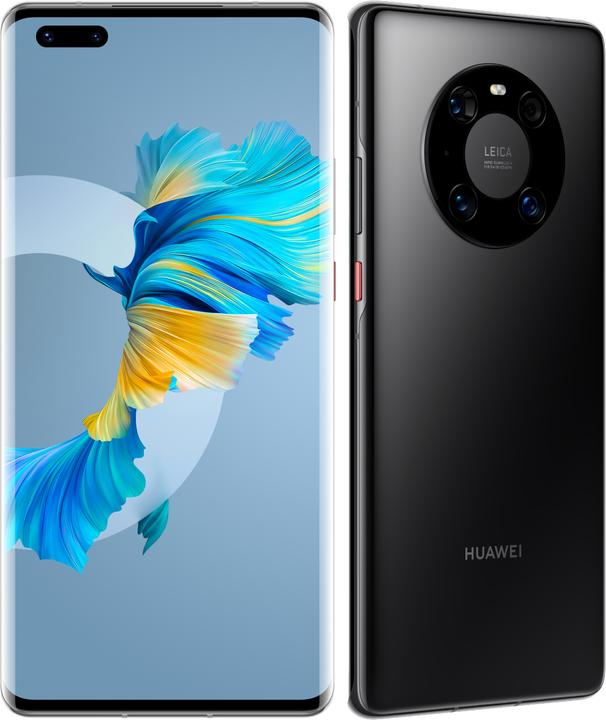
Huawei Mate 40 Pro review: Huawei (almost) achieves the impossible
Huawei’s fighting. Not for survival, but for the crown. The Huawei Mate 40 Pro is supposed to return the dethroned manufacturer to the position of market leader. Will it work? Maybe. The camera is top-notch and the Mate is surprisingly suitable for everyday use.
The Huawei Mate 40 Pro is not the best phone I’ve got my hands on in 2020, but it’s definitely the most interesting. No other phone is as well-equipped in terms of hardware and as eager to experiment as the Mate 40 Pro.

That leads us to our first conclusion. Namely, if you’re someone who simply wants a phone with a good camera straight out of the box, and you don’t want to have to worry about anything, the Huawei Mate 40 Pro isn’t the phone for you. So, the Mate 40 Pro fits right in with the entire Mate series, which has been Huawei's experimental product line since at least the Mate 20 Pro. You get bleeding-edge tech; it’s the newest of the newest, but perhaps not fully mature yet. This means that you as an enthusiast basically get a toy. Something you can explore, test out and play with, and not just be a user of.
And the Huawei Mate 40 Pro actually manages to be quite suitable for everyday use, despite the lack of Google Services. But it’s definitely not fully there, yet.
So, let's take a look at this flagship that’s made for enthusiasts.
The Kirin 9000: bam!
The Huawei Mate 40 Pro’s system-on-a-chip (SoC) is called the Kirin 9000. It’s Huawei’s newest, fastest and best chipset to date. And the specs sound cool:
- 5 nm design, so it’s energy efficient
- 15.3 million transistors, which is a great sales pitch
- native 5G, so it has fast data transfer and is future-proof
- The neural processing unit (NPU) is «integrated with an embedded Kirin ISP 6.0 for camera functions», so tech nerds have a cool phrase to throw around
In short, Huawei wants you to know that the Kirin 9000 is the best and strongest and absolutely best thing ever. To this end, Huawei’s marketing department has pulled out all the stops and is pounding out Apple-esque phrases.
And just like Apple, they have a tendency to be right when they claim these things. Because in practice, there’s nothing that makes the Kirin 9000 slow. And it’s not for lack of trying. You can usually punish a phone by shooting long, 4K videos at 60 frames per second. The P40 Pro overheats after about half an hour. But the Kirin 9000 keeps going. The phone does get warm, but it doesn’t overheat or get sluggish. Interesting. And super cool. The resulting 45-minute-long 4K60fps video, on the other hand, is mind-numbingly dull.
The Kirin 9000 also passed all other stress tests with flying colours. In the context of a smartphone, the Kirin 9000 exceeds current requirements. This can only mean one thing: there’s something else underway. What, exactly? Hard to say. The first step will certainly be HarmonyOS, which is supposed to be up to five times more efficient.
So, we have a damn strong platform and soon enough, we’ll have significantly more efficient software to go with it.
What’s all this power for, then?
I have no clue, but one thing is for sure: it’ll be freaking awesome.
The screen and its marketing promises... I call bullshit
Huawei claims it also paid special attention to the Mate 40 Pro’s screen. The Amoled display has a resolution of 2772 x 1344 pixels and 88-degree curved edges. And, in not quite as capital letters, Huawei is kinda sorta also proud of the fact that it’s a 90 Hz display – that means it displays 90 images per second. Normal smartphone screens stick to 60 Hz, while flagships refresh the image 120 times per second.
So, the Mate 40 Pro falls exactly between standard and flagship. It goes unnoticed. The frame rate of 90 frames per second is so inconspicuous that it could just as well be 60.

The manufacturer knows this, of course. This is exactly where it pays to take a hard look at marketing speak. Because no matter what a Richard Yu or Tim Cook says at a press conference or event, there's always something he doesn't say. The Mate 40's screen is the perfect example of this.
The screen is supposedly built this way because to be more power-efficient than the 120 Hz displays found in the competition. This sounds logical and is also technologically correct. But after two seconds of thought, the argument falls apart. A simple rule-of-thumb estimate suggests that the better screen shouldn’t have too negative an effect on battery life:
- The Huawei Mate 40 Pro has a 4,400 mAh battery
- The Kirin 9000 is manufactured using a 5 nm process, and is therefore more energy-efficient than its 7 nm cohorts
- The battery supports 66 W charging, which should keep the charging time short
- 5G eats a bit more power, but definitely not enough to bother the 4,400 mAh battery
- The competition has both decent battery performance, as well as 120 Hz displays
Still, the display is nicely calibrated. But the fact remains that when enthusiasts talk about Huawei, they rarely talk about beautiful displays (that’s usually where Samsung comes in). The camera is typically the topic of focus.
The camera: here we go
It took about two hours for the Huawei Mate 40 Pro to replace the P40 Pro as my on-the-go camera. For elaborate photos, I still rely on my Sony a7sii. But for snapshots on road trips or the like, there’s no question: the Mate 40 Pro is my go-to. This is despite the fact that the Mate 40 Pro's camera is not even the best in the Mate series. There’s actually another, better version than the one you can find in Swiss stores.
The camera system on the Mate 40 Pro looks like this:
- 50 MP, f/1.9, wide-angle lens
- 12 MP, f/3.4, 5x optical zoom, periscope lens with optical image stabilisation
- 20 MP, f/1.8, ultra wide-angle lens
And now, what the non-enthusiast in Switzerland doesn’t know: there’s a Pro+ version, too. The camera system on the Mate 40 Pro+ looks like this:
- 50 MP, f/1.9, wide-angle lens with optical image stabilisation
- 12 MP, f/2.4, 3x optical zoom, telephoto lens with optical image stabilisation
- 8 MP, f/4.4, 10x optical zoom, periscope telephoto lens with optical image stabilization
- 20 MP, f/2.4, ultra wide-angle lens
- Time-of-flight (ToF) depth sensor
However, the Pro+ version won’t be launched in Switzerland, since both the Pro and Pro+ are being manufactured in limited quantities. It’s a lame explanation, but there’s little we can do about it. Thanks, Huawei.
Be that as it may, even the weaker camera performs better than many a flagship. Actually, better than all other flagships. Not just because the camera records a lot, but also because the software behind the camera is extremely well optimised. We have the neural processing unit that’s integrated into an embedded 6.0 IPS... oh, Lord. That’s marketing babble for: recognizes images and scenes extremely quickly and knows all about the world. In short: initially, around the Mate 20, Huawei's beautifully dystopian-named Master AI only recognised a few things. These included «Blue Sky», «Animal» and «Food». By now, Emui 11 on the Huawei Mate 40 Pro pumps out a detailed analysis of pretty much everything.
There's «Cat», where the contrast and black levels are pushed so that every hair on the furry ball is as recognizable as possible...

.. «Snow», where the shades of grey are more refined and the image is slightly desaturated...

.. «Waterfall», where shutter speed is shortened so that every drop of water is made visible...

.. «Blue Sky», where the sky is made blue. Very blue.

There’s a lot more where that came from. The camera briefly identified the feline beast as «Panda» before deciding on «Cat». Then there’s sunrise, sunset, food, humans (portrait), car and so on. It’s impressive and delivers impressive images. It's no wonder the compact camera is joining the ranks of extinct forms of technology (like the fax), when a smartphone can do so much with what seems like so little effort.
Night mode, meanwhile, remains largely unchanged. While technologically impressive, the image is unrealistically overdone. But it could be and has been much worse.
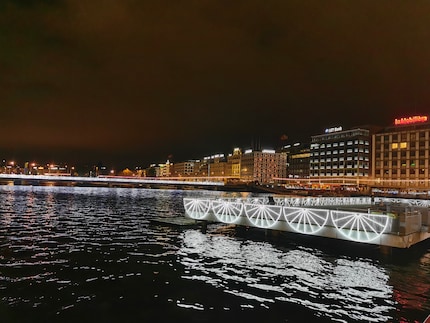
Looking through my photos and coming across this picture I shot in Geneva, I noticed something in the background: does night mode detect the city and filter accordingly? In consultation with video producer Stephanie Tresch, we think up an experiment designed to explain the camera's capabilities in the dark. First of all, we need a dark place. That’s not so easy to find in the immediate vicinity of Zurich, since light pollution colours the sky more or less orange, depending on the location. A forest in Aargau should solve that problem... at 6:00 a.m.
We take our little mascot, known as Horny the Pink Stuffed Unicorn, and wrap garland lights around him. Then we put him in the darkest possible pile of branches. The theory: the camera can’t recognise Horny and doesn’t see any lines in the background that it could interpret as buildings or nature.
Here’s the result in three pictures:
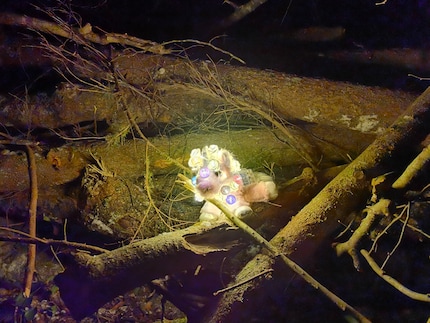
Close up, the artificial intelligence doesn’t recognise any scene, person or animal. In other words, we get an image that shows the camera's performance with only minimal software trickery. Since the shot is well lit, the camera doesn't have much trouble detecting branches, unicorns and lights.

At this distance, about three metres away, something strange happens. Again, the AI doesn’t recognise a scene or an object that it could optimise. But Horny suddenly has a kind of light halo. It’s certainly not visible in real life at 6:00 a.m. in this Aargau forest. It’s the result of some kind of blurring filter. Why, though? Is this a conflict between the brightening that takes place in night mode, the light and not recognising the scenery? Is the camera trying to interpret the light as an object, accentuating it, giving it clear edges and then softening it to remove any pixel noise?

At a distance of about five metres, the camera fails. It no longer recognises the stuffed unicorn. The digital image stabilisation also fails. We get a blurred image with a white blurb of light in the centre. The camera didn’t find anything to optimise. And you could see even less on the phone screen right before the shot.
The camera's night mode delivers significantly more when it gets scenery that the software recognises. The phone's NPU can then kick in, and it’s impressive. Without the AI, the pictures are still really good. But they’re far from the technological spectacle that’ll generate likes and comments on social media – you know, the ultra-optimised, ultra-calculated snapshot. And where the camera delivers enough good data during the day to digitally edit the images (with or without a recognised scene), it delivers only data garbage from a medium distance in the dark (with or without Photoshop).
The Google Thing and the surprising suitability for everyday use
The Huawei Mate 40 Pro is not Huawei's only project under active development. Huawei’s also working on a replacement for Google Services, because as of May 2019, at ex-US President Donald Trump’s behest, US companies are no longer allowed to work with Huawei. The reason? Suspicion of espionage. The result? The rug has been pulled out from under Huawei's feet; while Android can be used without Google Services and does fully work, you no longer have access to the Google app store or to a large number of APIs that Google makes available to developers.
Huawei's replacement products are «Huawei Mobile Services» and «App Gallery».
And a lot has happened with their development. The replacement APIs have always fulfilled their purpose so far; they do their thing in the background of the system, unnoticed. Good. As it should be. It just means there's just not much to say about it in a review. It works, cool, moving on.
The App Gallery is slowly but steadily maturing into an actually usable store. The number of apps is increasing steadily and becoming more and more interesting. And with this, the feeling that it’s a Chinese app store from China for China is also disappearing slowly but surely. The «Top Rated Apps» sound very familiar. There's meteoblue right next to Tinder, and Tutti.ch battling eat.ch for users' favour. I'd say that's a good thing, if it weren't for the annoying ads you get not only as unstoppable notifications, but also as a full screen in the App Gallery. Speaking of which, there’s now a browser version of it.
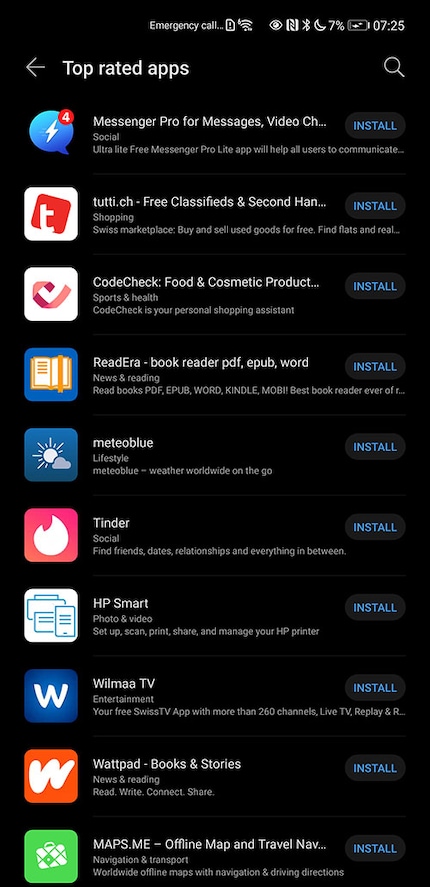
Should you not find an app in the App Gallery, you can still find it via Petal Search. After all, Android is still Android. This means you can install an APK, which is an app in its raw file format. All you need is said APK. You can find it using Petal Search, but I can't promise you that the app will work 100% of the time. This is because apps outside of the App Gallery often rely solely on Google Services, which the Huawei Mate 40 Pro lacks. The app may then crash, or some features simply won’t work. Huawei is developing its own replacement apps for this purpose. Instead of Google Maps, there’s Petal Maps, which is surprisingly elaborate. Among other things, Huawei has licensed map material from GPS manufacturer Tomtom, which is why Huawei can immediately offer a strong entry product.
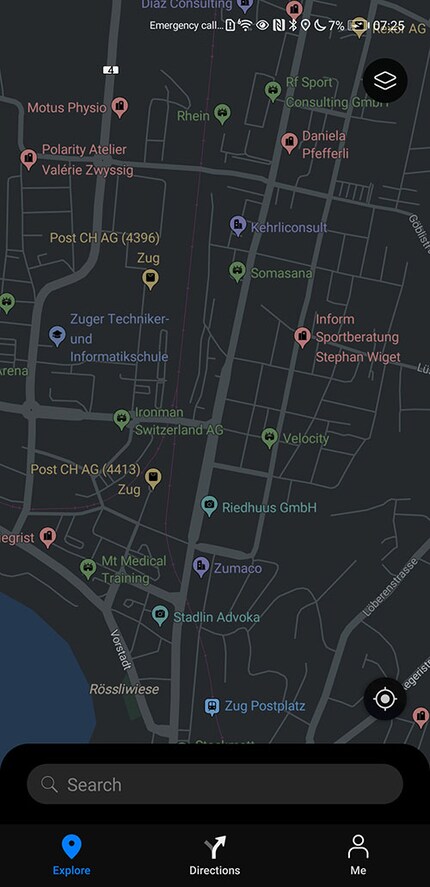
All in all, you have a phone that never gets boring. There’s always something going on. Perhaps a feature that’s being actively improved on, or a question to which the answer might only be revealed in a successor model. But above all, there's one thing: loads and loads of performance. The Huawei Mate 40 Pro is a true workaholic. It’s almost invincible when it comes to processing a workload.
And on the software side? That's where it gets exciting. For the first time since the sanctions, the Huawei is a phone that I would deem usable in the every day, even if still with limitations. The features are there, whether it's a weather app or a cloud solution for backing up your pictures. It's just not yet as unified and fluid as a modern software ecosystem should be.
If you want a phone that, above all, takes damn good pictures and you're willing to put in some minimal effort to sync the resulting data with the rest of your stuff, go for it. Huawei has pulled off an impressive coup: within two years, it launched an ecosystem, all while maintaining a leading position on the market, and surprising the world with the design of its phones.
Bam. Done. I like the thing. I like it a lot. And I’m convinced that the Mate 50, probably with HarmonyOS, will finally be the long-awaited, full-fledged competitor to Google.
Journalist. Author. Hacker. A storyteller searching for boundaries, secrets and taboos – putting the world to paper. Not because I can but because I can’t not.
